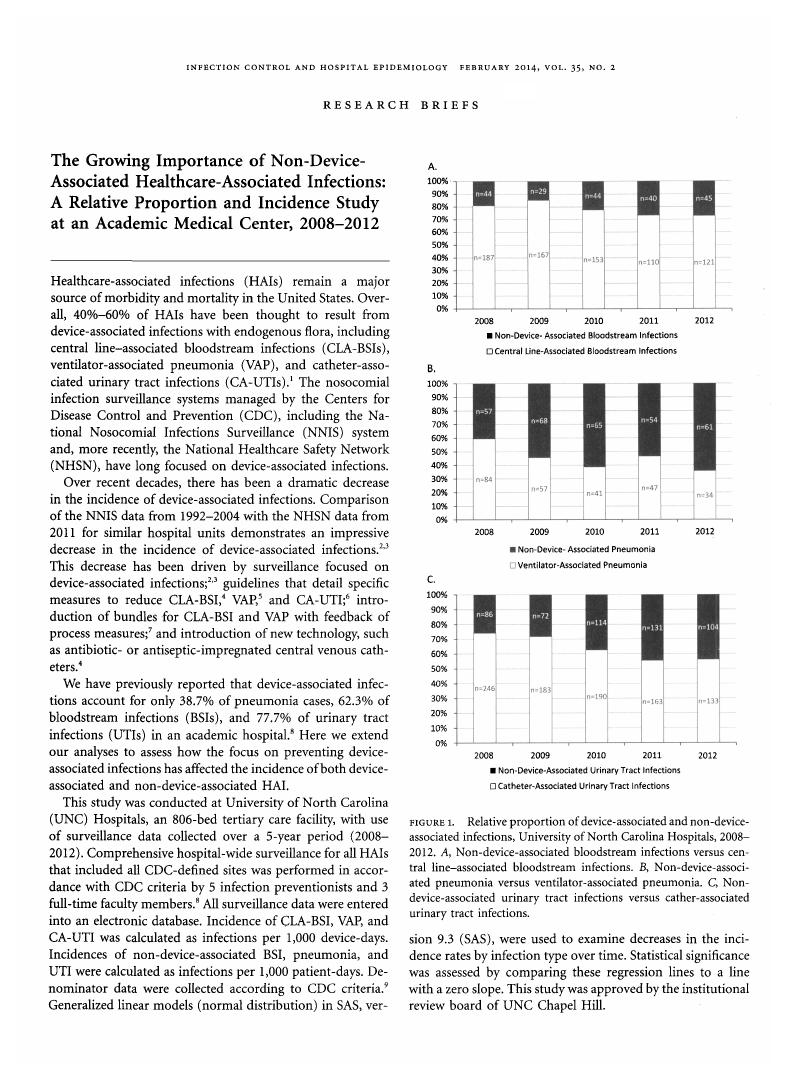Crossref Citations
This article has been cited by the following publications. This list is generated based on data provided by Crossref.
Kanamori, Hajime
Weber, David J.
DiBiase, Lauren M.
Sickbert-Bennett, Emily E.
Brooks, Rebecca
Teal, Lisa
Williams, David
Walters, Elizabeth M.
and
Rutala, William A.
2015.
Longitudinal Trends in All Healthcare-Associated Infections through Comprehensive Hospital-wide Surveillance and Infection Control Measures over the Past 12 Years: Substantial Burden of Healthcare-Associated Infections Outside of Intensive Care Units and “Other” Types of Infection.
Infection Control & Hospital Epidemiology,
Vol. 36,
Issue. 10,
p.
1139.
Álvarez, José A.
Ruíz, Susana R.
Mosqueda, Juan L.
León, Ximena
Arreguín, Virginia
Macías, Alejandro E.
and
Macias, Juan H.
2016.
Decontamination of stethoscope membranes with chlorhexidine: Should it be recommended?.
American Journal of Infection Control,
Vol. 44,
Issue. 11,
p.
e205.
Khan, Inam Danish
Basu, Atoshi
Kiran, Sheshadri
Trivedi, Shaleen
Pandit, Priyanka
and
Chattoraj, Anupam
2017.
Device-Associated Healthcare-Associated Infections (DA-HAI) and the caveat of multiresistance in a multidisciplinary intensive care unit.
Medical Journal Armed Forces India,
Vol. 73,
Issue. 3,
p.
222.
Weber, David J.
and
Rutala, William A.
2017.
Response to letter to the editor regarding “Occupational health risks associated with the use of germicides in health care”.
American Journal of Infection Control,
Vol. 45,
Issue. 1,
p.
97.
Baker, Dian
and
Quinn, Barbara
2018.
Hospital Acquired Pneumonia Prevention Initiative-2: Incidence of nonventilator hospital-acquired pneumonia in the United States.
American Journal of Infection Control,
Vol. 46,
Issue. 1,
p.
2.
Zhang, Yuzheng
Du, Mingmei
Johnston, Janice Mary
Andres, Ellie Bostwick
Suo, Jijiang
Yao, Hongwu
Huo, Rui
Liu, Yunxi
and
Fu, Qiang
2019.
Incidence of healthcare-associated infections in a tertiary hospital in Beijing, China: results from a real-time surveillance system.
Antimicrobial Resistance & Infection Control,
Vol. 8,
Issue. 1,
Ji, Wenjing
McKenna, Caroline
Ochoa, Aileen
Ramirez Batlle, Haiyan
Young, Jessica
Zhang, Zilu
Rhee, Chanu
Clark, Roger
Shenoy, Erica S.
Hooper, David
and
Klompas, Michael
2019.
Development and Assessment of Objective Surveillance Definitions for Nonventilator Hospital-Acquired Pneumonia.
JAMA Network Open,
Vol. 2,
Issue. 10,
p.
e1913674.
Baker, Dian
Quinn, Barbara
Ewan, Victoria
and
Giuliano, Karen K.
2019.
Sustaining Quality Improvement.
Journal of Nursing Care Quality,
Vol. 34,
Issue. 3,
p.
223.
Andersen, Bjørg Marit
2019.
Prevention and Control of Infections in Hospitals.
p.
45.
Strassle, Paula D.
Sickbert-Bennett, Emily E.
Klompas, Michael
Lund, Jennifer L.
Stewart, Paul W.
Marx, Ashley H.
DiBiase, Lauren M.
and
Weber, David J.
2019.
Incidence and risk factors of non–device-associated urinary tract infections in an acute-care hospital.
Infection Control & Hospital Epidemiology,
Vol. 40,
Issue. 11,
p.
1242.
Strassle, Paula D.
Sickbert-Bennett, Emily E.
Klompas, Michael
Lund, Jennifer L.
Stewart, Paul W.
Marx, Ashley H.
DiBiase, Lauren M.
and
Weber, David J.
2020.
Incidence and risk factors of non–device-associated pneumonia in an acute-care hospital.
Infection Control & Hospital Epidemiology,
Vol. 41,
Issue. 1,
p.
73.
Giuliano, Karen K.
and
Baker, Dian
2020.
Sepsis in the Context of Nonventilator Hospital-Acquired Pneumonia.
American Journal of Critical Care,
Vol. 29,
Issue. 1,
p.
9.
Mondal, Arnab
Devine, Ryan
Estes, Lori
Manuel, James
Singha, Priyadarshini
Mancha, Juhi
Palmer, Marley
and
Handa, Hitesh
2021.
Highly hydrophobic polytetrafluoroethylene particle immobilization via polydopamine anchor layer on nitric oxide releasing polymer for biomedical applications.
Journal of Colloid and Interface Science,
Vol. 585,
Issue. ,
p.
716.
Scannapieco, Frank A.
Giuliano, Karen K.
and
Baker, Dian
2022.
Oral health status and the etiology and prevention of nonventilator hospital‐associated pneumonia.
Periodontology 2000,
Vol. 89,
Issue. 1,
p.
51.
Laflamme, René
Putek, Piotr
Piasecki, Tomasz
and
Gotszalk, Teodor
2024.
Digital Analysis of Damped Vibrations.
IEEE Instrumentation & Measurement Magazine,
Vol. 27,
Issue. 5,
p.
52.
Kozub, Elizabeth
Gorzycki, Emily
Sidebottom, Abbey
Castro‐Pearson, Sandra
and
Bryant, Ruth
2025.
Implementation of a structured oral hygiene program through nursing assistant education to address non‐ventilator hospital‐acquired pneumonia: A quasi‐experimental study.
Journal of Nursing Scholarship,
Vol. 57,
Issue. 2,
p.
204.



